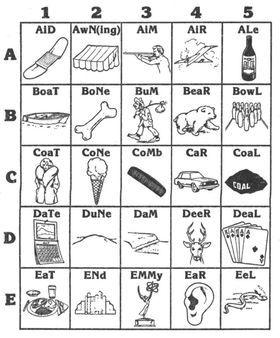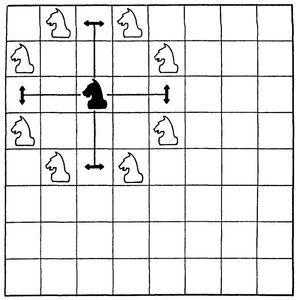How to Remember Anything: The Proven Total Memory Retention System (20 page)
Read How to Remember Anything: The Proven Total Memory Retention System Online
Authors: Dean Vaughn
Now, trace each oval, without the map, in the order of the sequence map, saying each audionym and the country it represents.

You should now be able to use a plain sheet of paper, without any reference, and draw the seven ovals representing the seven countries of Central America. The ovals should represent the name, location, and relative size of each country. When you can do this, you truly know the name of every country in the region, where it is located, and its relative size.
THE GRID SYSTEM
The Grid system has a lot of versatility because it is adjustable to the size
of a project. The grid is always set up as a square or a rectangle with alpha characters down the left side to identify the rows and numeric characters across the top to identify the columns.
Code Words are created in each block of the grid using the alpha symbols down the left side and the numeric symbols across the top of the grid.

Each Code Word, when used in the grid, becomes a topical location. For location C-2, the Code Word would begin with C and include the consonant N (for 2).
C
a
n
,
c
o
n
e, or
c
a
n
e would work.
For A=1 (
A
i
d
), see the Band-
A
i
d
on a specific arm of a specific person. For location E-4, see a specific
e
a
r
on a specific person.
A grid can be set up for any number of squares. When I use it, I normally set it up for only twenty-five locations, as in the illustration on
see here
.
A very practical application of the grid system is its flexible use for presentations. If your presentation is made up of fifteen major topics, you could set up a sixteen-square (4 × 4) grid. If you want to cover thirty major points in a presentation, you could set up a rectangular grid (5 squares times 6 squares).
In recalling the information in a grid, just move across the top row from left to right: A-1, A-2, A-3, and so on. You will know when you get to the end of the row. Then, recall rows B, C, D, and so on. I suggest that you begin by storing information in a nine- or sixteen-square grid (3 × 3 or 4 × 4).
You may wish to practice the use of the grid system by storing nine or sixteen random objects. You could even store two-digit numbers in each square by using your Key Words.
After you have stored the information randomly, you will be able to recall it in linear sequence. In fact, you will be able to recall it forward, backward, or diagonally! This adjustable system can be used instead of the Cube system, although it does not have the Cube’s advantage of sequentially numbering the information.
The grid system will give you another tool from which to choose when working on any memory project. It is organized, it is simple, and it is effective. It is an excellent tool for giving a presentation, because it can be tailor-made for the number of topics in your talk.
USE YOUR MEMORY TO DEVELOP CONCENTRATION
You say you have trouble concentrating? Surely, you know the value of being able to concentrate, but how do you learn to do it? How can you practice it? And how can you prove to yourself or anybody else that you are actually concentrating?
This chapter has a special exercise for practicing concentration. Complete the exercise and practice it frequently. You will be amazed at the dramatic improvement in your ability to concentrate. Even better, as you continue to practice, your ability to concentrate will improve dramatically. The exercise has a built-in measuring device so you can accurately monitor your progress.
One hot summer morning a long time ago, I got a call from one of the most successful head coaches in the history of professional football. He had seen me on a TV talk show and wondered if I could apply my memory techniques to concentration. I immediately said, “Yes, sir!” Only after I hung up did 1 begin to figure out how I could go about actually doing it. I had never found a project to which my learning systems could not be successfully applied, so I felt confident in giving an immediate and positive response. I was, however, surprised at the request for a memory technique to teach professional football players to concentrate. I would have expected him to ask me to teach the players to remember their plays.
I soon discovered that these big guys are also bright guys. Remembering plays was not a problem for them. The coach wanted to maximize his successes by minimizing his team’s errors. To do that, they had to learn to keep their minds on business.
Only the fans call professional football a game. Those who are responsible for making a profit from pro ball, and whose financial futures depend on its success, call football a business. There are few businesses in which organization and concentration are more critical.
In any business, of course, it is important to keep our minds on what we are doing. But in the business of football, it is especially important because everything happens so much faster. Even the slightest break in concentration can be extremely costly. If a player’s mind wanders from business at the wrong instant, even for a split second, it can mean a sudden and drastic change in that individual’s professional status and in the team’s overall success. A lack of concentration can come right down to a question of Super Bowl or superbomb. It can determine the color of the ink used in the profit-and-loss column.
Within two days of the coach’s call, I reported to the summer training camp with my concentration exercise. I was positive the system would work and I was excited about the technique. Not only would it help my favorite NFL team and my favorite coach, but it would also help millions of others to develop an extremely useful skill.
Developing the power to concentrate is exactly the same as developing any other skill. It takes practice. We exercise our bodies to have well-toned muscles. We practice a musical instrument to become skilled at it. Concentration is no different. If we want to teach ourselves to focus on a single thought or goal, we have to practice by doing it.
The mental exercise I designed for improving concentration uses a chessboard and the chess piece known as the Knight. I call this exercise the Tour of the Knight. It is accomplished with a paper and pencil.
In chess, each piece has specific moves that it must make. The Knight must jump two squares in one direction and one square in another, forming an L.
Below you see the Knight and all of its possible moves. Notice that the Knight can move only in the following directions:
Left two, up one.
Left two, down one.
Up two, left one.
Up two, right one.
Right two, up one.
Right two, down one.
Down two, right one.
Down two, left one.

Centuries ago, someone developed a way to move the Knight into all sixty-four squares of the chessboard without touching any of the same squares twice. The following illustration shows the Tour of the Knight, starting and ending on any square.

Even if you know nothing about the game of chess, this is an excellent exercise to improve your concentration skills.
The Tour of the Knight may not seem to have much going for it in practical application. But remember, we are not talking about the games of chess or football. We are talking about concentration. The exercising of our concentration “muscles” could just as easily be applied to any field where it is important to keep our minds on what we are doing.
Events that determine our value within an organization can change in no more time than it takes to miss an important point in a sales presentation because we were not concentrating. In the case of pro ball, a missed pass is the equivalent of a sale not made or a deal not concluded profitably.
To make a long story slightly longer, the team did learn the Tour of the Knight in only a few hours. Many reported it helped them with their concentration and the team finished in the NFL playoffs that season. Since then, many thousands of students have dramatically improved their ability to concentrate by learning and using this exercise.
Concentration is critical to success. The ability to concentrate can be instrumental in developing the ability to fix your attention on a goal. Ultimately, that may mean the difference between being a salesperson and being a
top
salesperson. It can be the difference between making a living—and making a fortune! It can help a person become a treasured employee. In academic life, concentration can make the difference between tolerable grades and being an honor student. The ability to concentrate, in short, can push you off the fence—and into greener pastures.
The remainder of this chapter is dedicated to one objective: to teach you
how to concentrate!
Please follow the exercise very carefully. Once you have learned the system, you will not only have learned a practical exercise for improving your concentration, you will have learned how to give a mind-boggling demonstration of memory power!
After studying this project for a while, I thought of a way to perform the demonstration without looking at the chessboard while doing it. It is more impressive to do it without looking at the board and it requires tremendous concentration. This mental exercise will develop your ability to concentrate and will also enable you to measure your results. If you make even one mistake, you will be unable to complete the tour.
Do you remember the game you may have played as a child in which each person in a circle had to remember, in sequence, the item mentioned by each previous person in the circle? The process continued as the number of items increased. Individuals who missed an item were eliminated from the circle.